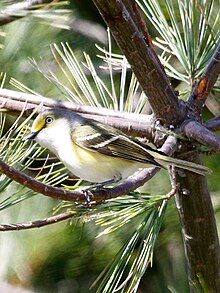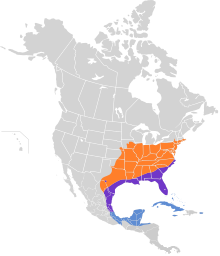| This article needs additional citations for verification. Please help improve this article by adding citations to reliable sources. Unsourced material may be challenged and removed. Find sources: "White-eyed vireo" – news · newspapers · books · scholar · JSTOR (December 2023) (Learn how and when to remove this message) |
| White-eyed vireo Temporal range: Late Pleistocene–present PreꞒ Ꞓ O S D C P T J K Pg N ↓ | |
|---|---|

| |
| Conservation status | |
 Least Concern (IUCN 3.1) | |
| Scientific classification | |
| Domain: | Eukaryota |
| Kingdom: | Animalia |
| Phylum: | Chordata |
| Class: | Aves |
| Order: | Passeriformes |
| Family: | Vireonidae |
| Genus: | Vireo |
| Species: | V. griseus |
| Binomial name | |
| Vireo griseus (Boddaert, 1783) | |

| |
The white-eyed vireo (Vireo griseus) is a small songbird of the family Vireonidae.
Distribution and habitat
It breeds in the eastern United States from New England west to northern Missouri and south to Texas and Florida, and also in eastern Mexico, northern Central America, Cuba and the Bahamas. Populations on the US Gulf Coast and further south are resident, but most North American birds migrate south in winter. This vireo frequents bushes and shrubs in abandoned cultivation or overgrown pastures.
Breeding
They nest near the ground in tangled thickets, they are made of weeds, leaves, grass, bark or any trash. The grass-lined nest is a neat cup shape, attached to a fork in a tree branch by spider webs. It lays 3–5 dark-spotted white eggs. Both the male and female incubate the eggs for 12–16 days. The young leave the nest 9–11 days after hatching.
Description
Measurements:
- Length: 4.3–5.1 in (11–13 cm)
- Weight: 0.3–0.5 oz (10–14 g)
- Wingspan: 6.7 in (17 cm)
Its head and back are a greyish olive, and the underparts are white with yellow flanks. The wings and tail are dark, and there are two white wing bars on each wing. The eyes have white irises, and are surrounded by yellow spectacles. Sexes are similar.
Call
The white-eyed vireo's song is a variable and rapid six to seven note phrase, starting and ending with a sharp chick.
Diet
During the breeding season, the diet of this species consists almost exclusively of insects, primarily caterpillars. In the autumn and winter it supplements its diet of insects with berries.
Taxonomy
The white-eyed vireo was described by the French polymath Georges-Louis Leclerc, Comte de Buffon in 1780 in his Histoire naturelle des oiseaux. The bird was also illustrated in a hand-coloured plate engraved by François-Nicolas Martinet in the Planches Enluminées D'Histoire Naturelle which was produced under the supervision of Edme-Louis Daubenton to accompany Buffon's text. Neither the plate caption nor Buffon's description included a scientific name but in 1783 the Dutch naturalist Pieter Boddaert coined the binomial name Tanagra grisea in his catalogue of the Planches Enluminées. Buffon specified that his specimen had come from Louisiana, but in 1945 the type locality was restricted to New Orleans. The white-eyed vireo is now placed in the genus Vireo was introduced in 1808 by the French ornithologist Louis Pierre Vieillot. The word vireo was used by Latin authors for a small green migratory bird, probably a Eurasian golden oriole but a European greenfinch has also been suggested. The specific epithet griseus is Medieval Latin for grey.
Six subspecies are recognised:
- V. g. griseus (Boddaert, 1783) – central and east US (includes noveboracensis)
- V. g. maynardi Brewster, 1887 – south Florida (southeast US)
- V. g. bermudianus Bangs & Bradlee, 1901 – Bermuda
- V. g. micrus Nelson, 1899 – south Texas (south US) and northeast Mexico
- V. g. perquisitor Nelson, 1900 – east Mexico
- V. g. marshalli Phillips, AR, 1991 – east central Mexico
The northern subspecies, V. g. noveboracensis, occupies most of the range of this species and is fully migratory. This sub-species is larger and has more brightly colored plumage than all other subspecies.
The resident southeastern coastal plain race, V. g. griseus is a slightly smaller and duller colored subspecies. It does not typically migrate out of its breeding range in the winter.
The resident Florida Keys race, V. g. maynardi, is greyer above and whiter below, and the south Texan V. g. micrus is like a smaller maynardi.
V. g. bermudianus is endemic to Bermuda, where it is known as the Chick of the Village. This has shorter wings and a duller plumage. Along with other endemic and native Bermudian birds, it was threatened with extinction following the loss of 8 million Bermuda cedar trees in the 1940s, and is now quite rare. This species is listed under the Bermuda Protected Species Act 2003.
Gallery
-
 White-eyed vireo (Vireo griseus) at Clarks River National Wildlife Refuge
White-eyed vireo (Vireo griseus) at Clarks River National Wildlife Refuge
-
 White-eyed vireo
White-eyed vireo
-
 Vireo griseus bermudianus in Bermuda
Vireo griseus bermudianus in Bermuda
-
 White-eyed vireo (Vireo griseus bermudianus) in Bermuda
White-eyed vireo (Vireo griseus bermudianus) in Bermuda
-
 White-eyed vireo
White-eyed vireo
-
 White-eyed vireo is drabber and has shorter wings.
White-eyed vireo is drabber and has shorter wings.
References
- BirdLife International (2021). "Vireo griseus". IUCN Red List of Threatened Species. 2021: e.T22705188A137793946. doi:10.2305/IUCN.UK.2021-3.RLTS.T22705188A137793946.en. Retrieved 20 October 2022.
- "THE BIRD BOOK".
- "White-eyed Vireo Identification, All About Birds, Cornell Lab of Ornithology". www.allaboutbirds.org. Retrieved 2020-09-27.
- Buffon, Georges-Louis Leclerc de (1780). "Le gris-olive". Histoire naturelle des oiseaux (in French). Vol. 7. Paris: De L'Imprimerie Royale. p. 392.
- Buffon, Georges-Louis Leclerc de; Martinet, François-Nicolas; Daubenton, Edme-Louis; Daubenton, Louis-Jean-Marie (1765–1783). "Tangara olive, de la Lousiane". Planches Enluminées D'Histoire Naturelle. Vol. 8. Paris: De L'Imprimerie Royale. Plate 714 Fig. 1.
- Boddaert, Pieter (1783). Table des planches enluminéez d'histoire naturelle de M. D'Aubenton : avec les denominations de M.M. de Buffon, Brisson, Edwards, Linnaeus et Latham, precedé d'une notice des principaux ouvrages zoologiques enluminés (in French). Utrecht. p. 45, Number 714 Fig. 1.
- Burleigh, T.D.; Lowery, G.H. Jr (1945). "Races of Vireo griseus in Eastern United States". American Midland Naturalist. 34 (2): 526–530. doi:10.2307/2421142. JSTOR 2421142.
- Paynter, Raymond A. Jr, ed. (1968). Check-list of Birds of the World. Vol. 14. Cambridge, Massachusetts: Museum of Comparative Zoology. pp. 113–114.
- Vieillot, Louis Pierre (1808). Histoire naturelle des oiseaux de l'Amérique Septentrionale : contenant un grand nombre d'espèces décrites ou figurées pour la première fois (in French). Vol. 1. Paris: Chez Desray. p. 83. The title page bears a date of 1807 but the volume did not appear until the following year.
- ^ Gill, Frank; Donsker, David, eds. (2019). "Shrikes, vireos, shrike-babblers". World Bird List Version 9.2. International Ornithologists' Union. Retrieved 24 August 2019.
- Jobling, James A. (2010). The Helm Dictionary of Scientific Bird Names. London: Christopher Helm. pp. 179, 402. ISBN 978-1-4081-2501-4.
- Dickinson, E.C.; Christidis, L., eds. (2014). The Howard & Moore Complete Checklist of the Birds of the World. Vol. 2: Passerines (4th ed.). Eastbourne, UK: Aves Press. p. 195. ISBN 978-0-9568611-2-2.
- Remsen, J.V. Jr.; Cardiff, S.W.; Dittmann, D.L. (1998). "Status and natural history of birds of Louisiana. I. Vireos (Vireonidae)" (PDF). Journal of Louisiana Ornithology. 4 (2): 59–102.
- "Birds: White-eyed Vireo (Vireo griseus bermudianus)". Department of Environment and Natural Resources of the Government of Bermuda. Retrieved 2021-10-03.
- "White-eyed vireo". Audubon Society of Bermuda. Audubon Society of Bermuda. Retrieved 2021-10-03.
External links
- Xeno-canto: audio recordings of the white-eyed vireo
- Bermuda Online: Bermudian Fauna
- Nature Conservation in Bermuda at Cave Biology.Com
- White-eyed Vireo Species Account - Cornell Lab of Ornithology
- Bird Banding at Caddo Lake (includes White-eyed Vireo photo)
- White-eyed Vireo Bird Sound at Florida Museum of Natural History
- Explore Species: White-eyed Vireo at eBird (Cornell Lab of Ornithology)
- White-eyed Vireo photo gallery at VIREO (Drexel University)
- White-eyed Vireo species account at Neotropical Birds (Cornell Lab of Ornithology)